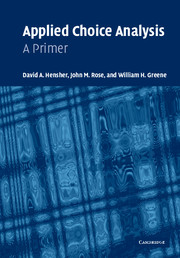13 - Allowing for similarity of alternatives
Published online by Cambridge University Press: 05 September 2012
Summary
For rarely are sons similar to their fathers: most are worse, and a few are better than their fathers.
(Homer, c.800BC–c.700BC)Introduction
The choice analysis undertaken in previous chapters has focused on the multinomial logit model (MNL). For many years this was the only easily estimated model in the sense of both available software and ease of interpretation and application. However, it was always recognized that the underlying IID condition was potentially limiting. IID had an equivalent behavioral association with a property knownas the Independence of Irrelevant Alternatives (IIA).
In words, the IIA property states that the ratio of the choice probabilities of any pair of alternatives is independent of the presence or absence of any other alternative in a choice set. A particularly important behavioral implication of IIA is that all pairs of alternatives are equally similar or dissimilar. For the set of attributes that are not observed, this amounts to assuming that all the information in the random components is identical in quantity and relationship between pairs of alternatives and hence across all alternatives (hence the IID condition).
While on first appreciation this is a worrying assumption, it is on balance a very useful simplification that may not necessarily be too unreasonable. If the analyst can do a good job of maximizing the amount of information in the observed component of utility (i.e. Vj), resulting in a minimal amount of information in the unobserved component (i.e. ε j), then any assumption imposed on ε j, no matter how unrealistic, is likely to be of small consequence. Unfortunately the ability of the analyst to deliver such quality information cannot be assured.
- Type
- Chapter
- Information
- Applied Choice AnalysisA Primer, pp. 479 - 517Publisher: Cambridge University PressPrint publication year: 2005



